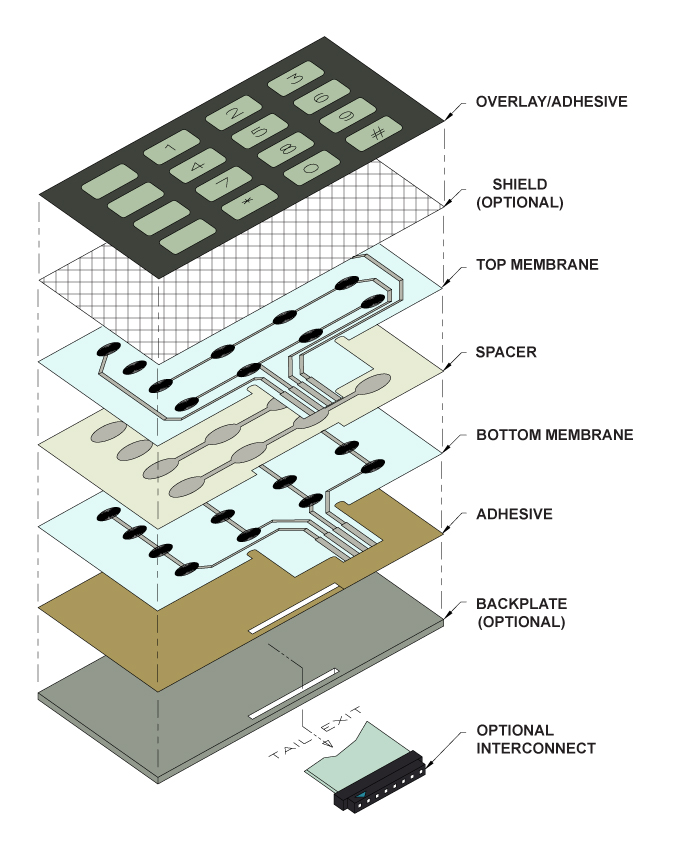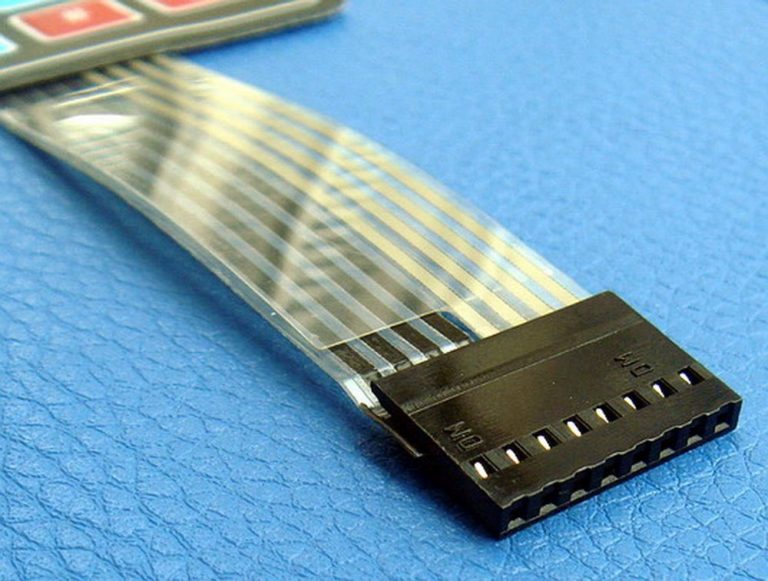If durability matters, sourcing from a reliable membrane switch manufacturer is crucial.
If durability matters, sourcing from a reliable membrane switch manufacturer is crucial.
Blog Article
All About Membrane Change: Comprehending Its Design and Functionality
When you think concerning the control user interfaces in contemporary gadgets, membrane switches typically come to mind. Let's discover what sets membrane layer switches apart from other control systems.
What Are Membrane Buttons?

Membrane switches can additionally be customized pertaining to form, dimension, and graphics, permitting manufacturers to develop distinct user interfaces tailored to certain products. Overall, membrane layer buttons play a significant function in boosting user experience throughout a wide variety of applications.
Just How Membrane Switches Over Work
When you press a trick on a membrane button, it turns on a straightforward yet effective system. membrane switch manufacturer. The leading layer, often made of flexible material, pushes down onto a conductive layer below it.
You'll observe that the tactile feedback differs based upon the button style, supplying either a soft click or a more obvious response. When you release the trick, the membrane layer go back to its initial placement, reopening the circuit and stopping the signal. This process occurs nearly instantaneously, ensuring a receptive customer experience.
Membrane buttons are popular because of their durability and resistance to dust and dampness, making them suitable for numerous applications, from family appliances to medical devices. Recognizing this operation helps you appreciate their extensive usage.
Key Parts of Membrane Layer Buttons
Comprehending the crucial elements of membrane layer switches is basic for understanding their performance and design. At the core, you'll find the visuals overlay, which offers the aesthetic user interface for individuals. Beneath that, there's a spacer layer that divides the circuit layers, making certain that they don't make contact till pressed. The circuit layer is where the magic happens; it contains conductive traces that finish the circuit when you press the switch. One more vital component is the adhesive backing, allowing the button to follow surface areas firmly. Ultimately, the safety layer shields against environmental factors and put on, extending the switch's life expectancy. Each part plays a significant function in making sure dependable efficiency and customer communication. By understanding these components, you'll obtain understanding into exactly how membrane layer switches run and their significance in numerous applications.
Materials Made Use Of in Membrane Change Layout
The performance and durability of membrane layer changes heavily depend on the materials made use of in their style. You usually run into polyester and polycarbonate as main substratums as a result of their outstanding toughness and adaptability. These products resist scratches and chemicals, making them excellent for demanding atmospheres.
The conductive layers commonly utilize silver or carbon, chosen for their integrity and conductivity. membrane switch manufacturer. Silver supplies premium performance, while carbon is an economical option. For the overlay, you could think about a matte or glossy surface, relying on your aesthetic requirements and customer experience
Adhesives play an important role too; they bond layers securely and guarantee longevity. Make certain to select adhesives that endure ecological factors like temperature level and humidity. Finally, do not ignore the value of a great printing technique for graphics, as it boosts both functionality and visual appeal. Choosing the right materials will ensure your membrane switch stands the test of time.
Design Considerations for Membrane Buttons
While making membrane layer buttons, it's important to think about various factors that affect their performance and individual experience. Beginning by concentrating on the layout and switch dimension; ensure they're intuitive and simple to navigate. Think about the tactile responses you want to offer-- will individuals require a recognizable click or a softer touch? Additionally, consider the materials you'll utilize, as they'll affect toughness and visual appeals.
Don't forget the graphic style; clear labeling and color comparison are substantial for visibility. Verify your layout accommodates environmental elements, like dampness or temperature variants, which can affect performance. Bear in mind the importance of testing models with actual customers to collect responses and make required adjustments. This iterative process helps you refine the style, verifying it meets both functional and visual demands successfully. By meticulously considering these elements, you'll develop a membrane layer button that boosts use and fulfillment.
Applications of Membrane Layer Switches
Membrane layer switches are functional elements found in various applications, from commercial devices to consumer electronic devices. You'll see their impact in makers that call for resilient user interfaces and in tools that profit from streamlined styles. Recognizing these applications assists you value the performance and practicality of membrane switches in everyday innovation.
Industrial Devices Use
When you're wanting to improve the performance of commercial devices, membrane layer switches use a trusted option that combines toughness with user-friendly layout. These switches are best for severe atmospheres, offering resistance to dirt, dampness, and chemicals. You'll discover them in control panels for making devices, HVAC systems, and medical tools, where accuracy and responsiveness are essential. Their reduced profile suggests they fit seamlessly right into various tools, conserving valuable area while investigate this site keeping ease of usage. With personalized graphics and backlighting options, you can produce an instinctive user interface for operators, enhancing resource performance and safety and security. And also, their long life-span reduces maintenance costs, making them a clever investment for your industrial applications. Embrace membrane layer buttons to streamline your operations and enhance total efficiency.
Customer Electronic Devices Integration
In the domain name of consumer electronic devices, membrane layer switches play an essential duty in improving user interaction and tool functionality. Membrane buttons also ensure durability and resistance to dust and moisture, prolonging the life expectancy of your electronics. By selecting membrane layer switches, you boost not just the functionality but also the style of your gadgets, making everyday communications smooth and pleasurable.
Advantages and Drawbacks of Membrane Layer Switches
While membrane layer buttons use a variety of benefits, they additionally come with some disadvantages that you should take into consideration. One considerable advantage is their portable design, making them suitable for space-constrained applications. They're additionally economical, supplying a resilient remedy with a low production expense. Furthermore, their smooth surface is easy to clean, improving health in atmospheres like medical facilities.

Membrane layer buttons can have a shorter life expectancy compared to mechanical website here buttons, specifically under heavy usage. They can likewise be much less responsive, which might impact customer responses during procedure. Stabilizing these pros and disadvantages will certainly assist you identify if membrane buttons are the appropriate fit for your job.
Regularly Asked Concerns
How Much Time Do Membrane Layer Switches Usually Last?
Membrane layer changes commonly last in between 5 to 10 years, depending upon usage and environmental conditions. You'll wish to examine variables like wear, exposure to wetness, and temperature level variations to determine their longevity successfully.
Can Membrane Layer Switches Over Be Personalized for Specific Layouts?
Yes, you can personalize membrane buttons to fit particular styles (membrane switch manufacturer). You'll have the freedom to pick shades, shapes, and formats that match your job's requirements, guaranteeing they mix effortlessly with your total visual
What Is the Price Array for Membrane Change Production?
The cost range for membrane button manufacturing typically falls in between $1 and $10 per device, depending on elements like design intricacy, amount, and products. You can obtain quotes from suppliers to discover the ideal alternative.

Are Membrane Layer Changes Water Resistant or Immune?
Membrane layer switches can be made to be water-proof or immune, depending on materials made use of and construction approaches. If you need them for damp settings, ensure you specify those requirements during the layout process.
Just How Do Membrane Switches Compare to Typical Switches?
Membrane switches are normally thinner and more versatile than conventional switches, providing a streamlined layout. They're commonly less complicated to clean up and integrate, however could not supply the tactile comments you're utilized to with mechanical choices.
Verdict

Report this page